Can I Drive with P0440? How Much to Fix EVAP?

Ever had your check engine light come on, and after a quick scan with an OBD-II tool, you see P0440 staring back at you? If you’re like most of us car enthusiasts, the first thought is usually: “Uh-oh, how bad is this? Can I still drive? And how much is this going to set me back?”
I remember the first time I got a P0440 code on my old Chevy Blazer. My heart sank, thinking it was some major engine problem. But after a bit of digging, I realized it was tied to the EVAP system (short for Evaporative Emission Control System). Turns out, it wasn’t catastrophic, but it wasn’t something I could just ignore forever either.
So, let’s dive in and talk about whether you can drive with P0440, what it really means, and how much it’ll cost to fix. I’ll keep things simple, direct, and friendly—like we’re just hanging out in the garage chatting about cars.
What Does P0440 Mean?
At its core, P0440 is an EVAP system code. It tells you that the onboard computer detected a general fault in the system that controls fuel vapors. Instead of letting raw fuel vapors escape into the atmosphere (which is bad for both the planet and your wallet), the EVAP system traps them and burns them later in the engine.
Common Causes of P0440
- Loose or faulty gas cap (this is the #1 culprit, no joke).
- Cracked or damaged EVAP hoses.
- Faulty purge valve.
- Leaking or broken charcoal canister.
- Bad vent valve or solenoid.
- Wiring or connector issues to EVAP components.
The tricky part? P0440 is pretty broad. Unlike codes like P0442 (small leak) or P0455 (large leak), P0440 just says: “Hey, something’s wrong in the EVAP system.”
Can You Drive with P0440?
This is the big question, right?
Short Answer: Yes, You Can Drive… For Now
Driving with P0440 won’t usually leave you stranded. Your car will still run and drive normally, because this code doesn’t directly affect the combustion process or critical engine performance.
But here’s the catch:
- Fuel Efficiency May Drop: If vapors aren’t recycled properly, you might burn a little more gas.
- Emissions Will Be Higher: If you care about passing a smog test, forget it—P0440 is an automatic fail in most states.
- The Real Problem Might Grow: What starts as a loose gas cap today could turn into a failing purge valve tomorrow.
Think of it this way: Driving with P0440 is kind of like driving with a slow leak in your tire. You’ll get by for a while, but if you ignore it too long, it’ll catch up to you.
Symptoms of P0440
You might be surprised, but many times, you won’t notice any symptoms beyond the check engine light. Still, there are a few telltale signs:
- Check Engine Light (CEL) – the obvious one.
- Slight fuel odor near the car, especially around the fuel tank.
- A faint drop in MPG.
- Failed emissions test.
That’s about it. Unlike misfire codes (which cause rough idling or loss of power), P0440 is sneaky and quiet.
How to Diagnose P0440
Want to play backyard mechanic and figure it out before spending money at the shop? Totally doable.
Step 1: Check the Gas Cap
- Make sure it’s tightened properly (listen for the 3 clicks).
- Inspect the rubber seal for cracks or wear.
- If it’s old, replace it (usually $15–$30).
Step 2: Visual Inspection
- Look at all visible hoses around the EVAP system for cracks or loose connections.
- Check under the car near the charcoal canister.
Step 3: Smoke Test (Advanced)
Shops use a smoke machine to push harmless smoke into the EVAP system. If smoke escapes, bam, there’s your leak.
How Much Does It Cost to Fix EVAP (P0440)?
Now, let’s talk money—the part everyone dreads. The cost really depends on the root cause.
Typical Fixes and Costs
- Gas cap replacement: $15–$50.
- EVAP purge valve: $150–$300 (parts & labor).
- Vent valve replacement: $200–$400.
- Charcoal canister replacement: $300–$600.
- Hose repairs: $100–$200.
- Smoke test diagnostic at shop: $75–$150.
DIY vs. Mechanic
- If you’re handy and it’s just a gas cap or a hose, you can do it yourself for pocket change.
- If it’s deeper in the system, like the canister or solenoids, a pro mechanic is worth it—trust me, fishing around under the car chasing vapor leaks can be a pain.
Is Fixing P0440 Urgent?
Here’s where most people get stuck: Do I need to fix this right now?
The Honest Truth: It’s Not Immediate, But Don’t Ignore It Forever
- Not urgent for drivability: Your car won’t stall, and you won’t blow the engine by ignoring it short term.
- Urgent for emissions & savings: Over time, you waste fuel and contribute to pollution. Plus, if your state requires inspections, you’ll fail until it’s fixed.
- Peace of mind: Nothing’s worse than the check engine light being always on. Because then if a new problem pops up, you won’t know until it’s serious.
Tips to Save Money on EVAP Repairs
- Start with the gas cap – cheapest and most common fix.
- Scan codes yourself – a $25 OBD-II scanner can save you hundreds in diagnostic fees.
- Don’t rush to replace everything – some mechanics shotgun parts (replace multiple components “just in case”), which adds up fast.
- Check for recalls – certain makes/models had EVAP-related recalls that might cover your repair.
- Go aftermarket – OEM parts are great, but quality aftermarket EVAP parts can save you 30–40%.
FAQs About P0440
Will P0440 Damage My Engine?
Nope. It won’t damage your engine directly. But ignoring it long-term could stress other parts of the EVAP system.
How Long Can I Drive with P0440?
Technically, for months… but you risk fuel economy loss and failing emissions. Best to fix it within a few weeks.
Can I Reset the Code and Pass Emissions?
Nope. The system runs self-checks, and if the problem is still there, the light comes back before inspection.
Conclusion
So, can you drive with P0440? Absolutely—your car won’t leave you stranded. But should you drive with it long-term? Not if you care about fuel economy, emissions, or passing your next inspection.
The fix could be as cheap as a $20 gas cap or as expensive as a $600 charcoal canister replacement. That’s why a little DIY diagnosis goes a long way.
At the end of the day, fixing P0440 isn’t about keeping your car running—it’s about keeping it efficient, clean, and headache-free. And hey, isn’t it nicer to see that dashboard without the check engine light glowing back at you? 😉





![Can A Engine Lean 1 Cause P0706 Code [Explained]](https://automotiveglory.com/wp-content/uploads/2024/05/can-a-engine-lean-1-cause-p0706-code-explained_6155-768x529.jpg)
